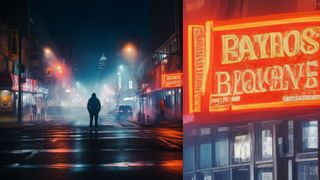Generative or genuine? My 5 surefire ways to spot an AI generated image
AI-generated images might look impressively realistic at first glance, but look closer and you’ll soon see the cracks…
Generative AI may not be photography - but it is creating increasingly photo-realistic images. But despite the advances, even the best AI generators are far from perfect. And you can spot an AI image, if you know where to look. Here are five surefire signs that the photo you are looking it has been created by prompts typed into a program, rather than having being shot by a camera…
1: Hands and shoelaces

Generative AI excels at making six-fingered mutations, misshapen mitts and sinister meat hooks that look like they need to be hacked off with a chainsaw, Evil Dead-style. But it can’t do realistic-looking hands. So if you want to know if a portrait is AI-generated or not, first check whether the hands look natural, count the fingers and note the length of the pinky and thumb (look for unnatural-length limbs and overly prominent neck bones too). The most up-to-date AI tools are getting better with hands, but they still struggle, especially when the hand is holding something. The reason for this is that they’re far more complex than most other body parts, and they can be shaped in all manner of ways. AI does generic things very well but there’s no single generic hand shape, so AI struggles to determine a type of hand that fits with the image. The same applies for shoelaces, which almost always look plain wrong.
2: Lack of detail

The highest resolution in MidJourney is currently 4096x4096 pixels (all those prompts that include things like ‘8K’ are entirely pointless). This can be increased using AI upscalers like Topaz AI. But the level of detail still can’t compare to the best smartphones, let alone a mid-range DSLR or mirrorless camera. You notice this lack of resolution and detail in textures like skin, which rarely show pores and instead have a smudginess to them, as if captured through a selfie camera with a ‘portrait glow’ mode. Backdrops in portraits are almost always out of focus and detail-less too. If you look closely at landscapes you’ll also find that textures like foliage or rocks tend to blend into one another. Any text in the scene - like street signs, packaging or logos on clothing - is also a dead giveaway as it is always a garbled mess of nonsense letters and symbols.
3: Fake action

AI is very good at making static pictures of people standing still, looking at the ‘camera’ or gazing pensively to one side. It can certainly do faces. Faces bejewelled, masked and painted. Faces with huge eyes and cute freckles. Faces shattering into a thousand butterflies. But it struggles to convey off-the-cuff moments of motion unless those moments follow cinematic action tropes, like a balletic sword-fight or a person running from an explosion. Ask for a candid photo and you’re likely to get a perfectly staged composition. Everyday, realistic-looking motion is trickier. Everything tends to look posed, even seemingly spontaneous moments.
4: Overly dramatic lighting

Portraits tend to have dramatic side or backlighting…

… and landscapes look almost too epic
If you’re learning about lighting in photography, one of the best things you can do is study photos that appeal to you and try to work out where the lights have been placed. With generative AI images, if you do the same thing you see patterns of lighting styles quickly emerge. Portraits tend to have a ‘kicker’, a light from behind that lifts the edge of the subject’s face and hair. They also often have a cinematic warm/cool split to the lighting, as if lit with a cool blue light to one side and a warm orange light to the other. As for landscapes, AI scenes tend to have an overabundance of atmosphere, as in misty backdrops or an orange glow from the setting sun.
5: Beautiful people

Who’s to say what is beautiful and what isn’t? With generative imaging, a beautiful person is usually young, thin, over-sexualised, and - for the most part - white. What’s more, generated faces all tend to have a generic attractive quality to them. If you try prompting specifically for normal-looking or even unattractive people you’ll often get a Hollywood version of ugly, as in ‘put some glasses on a pretty face’ ugly. It seems that rather than offering an infinite number of faces, instead we get infinite variations on the same face. More specific prompts like ‘plain-looking’ lead to attractive women without makeup, and including specific details like ‘acne’ or ‘bad teeth’ tend to result in a horror-movie style of character. Age bias also comes into play, it seems ‘plain looking’ is interpreted as wrinkly. The reasons for this are obvious. There are simply far more photos of conventionally pretty people online. This is what the models have been trained on, so the generator thinks of ‘normal’ as a catalogue model. Maybe it’s not such a bad thing, it’ll make it easier for us normal-looking humans to hide when the robots take over.
All images were made in MidJourney
Get the Digital Camera World Newsletter
The best camera deals, reviews, product advice, and unmissable photography news, direct to your inbox!
The lead technique writer on Digital Camera Magazine, PhotoPlus: The Canon Magazine and N-Photo: The Nikon Magazine, James is a fantastic general practice photographer with an enviable array of skills across every genre of photography.
Whether it's flash photography techniques like stroboscopic portraits, astrophotography projects like photographing the Northern Lights, or turning sound into art by making paint dance on a set of speakers, James' tutorials and projects are as creative as they are enjoyable.
He's also a wizard at the dark arts of Photoshop, Lightroom and Affinity Photo, and is capable of some genuine black magic in the digital darkroom, making him one of the leading authorities on photo editing software and techniques.